Summary of SST data for FACE-IT study sites
Robert Schlegel
20 December 2023
Last updated: 2023-12-20
Checks: 7 0
Knit directory: WP1/
This reproducible R Markdown analysis was created with workflowr (version 1.7.1). The Checks tab describes the reproducibility checks that were applied when the results were created. The Past versions tab lists the development history.
Great! Since the R Markdown file has been committed to the Git repository, you know the exact version of the code that produced these results.
Great job! The global environment was empty. Objects defined in the global environment can affect the analysis in your R Markdown file in unknown ways. For reproduciblity it’s best to always run the code in an empty environment.
The command set.seed(20210216) was run prior to running
the code in the R Markdown file. Setting a seed ensures that any results
that rely on randomness, e.g. subsampling or permutations, are
reproducible.
Great job! Recording the operating system, R version, and package versions is critical for reproducibility.
Nice! There were no cached chunks for this analysis, so you can be confident that you successfully produced the results during this run.
Great job! Using relative paths to the files within your workflowr project makes it easier to run your code on other machines.
Great! You are using Git for version control. Tracking code development and connecting the code version to the results is critical for reproducibility.
The results in this page were generated with repository version 2d40e16. See the Past versions tab to see a history of the changes made to the R Markdown and HTML files.
Note that you need to be careful to ensure that all relevant files for
the analysis have been committed to Git prior to generating the results
(you can use wflow_publish or
wflow_git_commit). workflowr only checks the R Markdown
file, but you know if there are other scripts or data files that it
depends on. Below is the status of the Git repository when the results
were generated:
Ignored files:
Ignored: .Rhistory
Ignored: .Rproj.user/
Ignored: .httr-oauth
Ignored: code/.Rhistory
Ignored: data/analyses/clean_all.RData
Ignored: data/analyses/clean_all_clean.RData
Ignored: data/analyses/ice_4km_proc.RData
Ignored: data/full_data/
Ignored: data/sst_trom.RData
Ignored: metadata/globalfishingwatch_API_key.RData
Ignored: metadata/is_gfw_database.RData
Ignored: metadata/pangaea_parameters.tab
Ignored: metadata/pg_EU_ref_meta.csv
Ignored: mhw-definition_1_orig.xcf
Ignored: poster/SSC_2021_landscape_files/paged-0.15/
Ignored: presentations/.Rhistory
Ignored: presentations/2023_Ilico.html
Ignored: presentations/2023_LOV.html
Ignored: presentations/2023_results_day.html
Ignored: presentations/2023_seminar.html
Ignored: presentations/2023_summary.html
Ignored: presentations/ASSW_2023.html
Ignored: presentations/ASSW_side_2023.html
Ignored: presentations/Session5_SCHLEGEL.html
Ignored: shiny/dataAccess/coastline_hi_sub.csv
Ignored: shiny/kongCTD/.httr-oauth
Ignored: shiny/kongCTD/credentials.RData
Ignored: shiny/kongCTD/data/
Ignored: shiny/test_data/
Note that any generated files, e.g. HTML, png, CSS, etc., are not included in this status report because it is ok for generated content to have uncommitted changes.
These are the previous versions of the repository in which changes were
made to the R Markdown (analysis/sst_summary.Rmd) and HTML
(docs/sst_summary.html) files. If you’ve configured a
remote Git repository (see ?wflow_git_remote), click on the
hyperlinks in the table below to view the files as they were in that
past version.
| File | Version | Author | Date | Message |
|---|---|---|---|---|
| html | 0926ac4 | Robert William Schlegel | 2023-12-12 | Build site. |
| html | 7ad8a78 | Robert William Schlegel | 2023-12-12 | Build site. |
| html | 77b2a61 | Robert | 2023-12-04 | Build site. |
| html | 610ff35 | Robert | 2023-08-30 | Build site. |
| html | 6ad5b79 | Robert William Schlegel | 2023-08-24 | Build site. |
| html | bd4819b | Robert | 2023-08-23 | Build site. |
| html | 4ddbb12 | robwschlegel | 2023-07-24 | Build site. |
| html | e8997de | Robert | 2023-05-30 | Build site. |
| html | 2ea419c | Robert | 2023-05-30 | Build site. |
| html | f59b5f2 | robwschlegel | 2022-11-28 | Re-published site |
| html | cc87bdd | Robert | 2022-09-23 | Build site. |
| html | 8a8fd0b | Robert | 2022-05-27 | Build site. |
| html | b32f47e | robwschlegel | 2022-04-21 | Build site. |
| html | 1d3a3b3 | Robert | 2021-12-17 | Build site. |
| html | 122fbe4 | Robert | 2021-12-17 | New Young Sound data |
| html | 0d6d433 | Robert | 2021-12-15 | Build site. |
| html | cf10066 | robwschlegel | 2021-12-15 | Build site. |
| Rmd | dd7b8a0 | robwschlegel | 2021-12-15 | Re-built site. |
| html | dd7b8a0 | robwschlegel | 2021-12-15 | Re-built site. |
| html | 4cdbd33 | robwschlegel | 2021-12-15 | Build site. |
| Rmd | 993272c | robwschlegel | 2021-12-15 | Re-built site. |
| html | 5ba8046 | Robert | 2021-12-15 | Build site. |
| Rmd | bc740fa | Robert | 2021-12-15 | Added a bit of text |
| html | bc740fa | Robert | 2021-12-15 | Added a bit of text |
| html | 57f4772 | Robert | 2021-12-15 | Build site. |
| Rmd | 713428c | Robert | 2021-12-15 | Calculated SST trends for all model data |
| html | 713428c | Robert | 2021-12-15 | Calculated SST trends for all model data |
| html | 1beea50 | Robert | 2021-12-14 | Build site. |
| html | b554c7a | Robert | 2021-12-14 | Fixed labelling for CCI SST figures |
| html | 1da6285 | Robert | 2021-12-14 | Build site. |
| Rmd | 1b3e2f2 | Robert | 2021-12-14 | Added CCI SST analysis and figures to the SST data page |
| html | 1b3e2f2 | Robert | 2021-12-14 | Added CCI SST analysis and figures to the SST data page |
| html | 860f5d3 | Robert | 2021-12-10 | Build site. |
| html | 2725466 | Robert | 2021-12-10 | Merge |
| html | 64a5252 | Robert | 2021-12-10 | Build site. |
| html | 807675e | robwschlegel | 2021-12-06 | Build site. |
| html | 104acbc | Robert | 2021-12-03 | Build site. |
| Rmd | e8e7420 | Robert | 2021-12-03 | SST analysis figures |
| html | e8e7420 | Robert | 2021-12-03 | SST analysis figures |

Overview
This document contains a summary of the NOAA OISST, CCI SST (sea surface temperature), and model data that have been extracted around the FACE-IT sites. Both satellite products have daily data from 1982 to 2020 however, the NOAA data are on a 0.25° grid while the CCI data are at 0.05°. This difference in the size of the pixels allows for some dramatic differences int he observed temperatures along the coast and in the fjords, as well as the decadal trends of those temperatures. Most importantly, the NOAA pixels are too coarse to capture SST within most of the FACE-IT fjords while CCI is able to provide SST in all sites. The coastal/fjord pixels in the CCI data also tend to show strong cooling trends. I assume that these cooling trends are an artefact of the increased glacial melting into the fjord. But we can’t rule out that they are caused by any of the common remotely sensed coastal pixel issues, such as land bleed, which can interfere with the accurate assimilation of the data. Regardless, even in the more open coastal waters these two products do not agree very closely with one another and this is cause for some alarm. It is known that remotely sensed products begin to differ significantly from one another when approaching the poles and the quick analysis performed here certainly confirms that once again.
The model data used here run from 2000-2099 and area available for three different climate pathways (RCP: 2.6, 4.5, 8.5) and at multiple depths (0, 50, 100, 200 m). The model is not generated on a Cartesian coordinate system so the values are shown as points, rather than as a raster. The model projections for RCP 8.5 tend to produce decadal trends that are similar to the NOAA OISST trends, implying that the current pathway we are on is 8.5, which matches most of the past literature, but moving forward we may be coming closer to RCP 7.0. Note also that the present day SST values between the model and the NOAA OISST values tend to match ore closely than to the CCI SST.
The rest of this page provides the results of the analysis by FACE-IT site. One may use the table of contents on the left to jump to a desired section. Each figure shown here has two panels: A) The average temperatures from 1982-2020, and B) The decadal trend over the same period. The first figure shows the results from the NOAA OISST data, the second for the CCI SST data, and the third for the model. Note that the model was not run for the western side of Greenland so there are no data available for Disko Bay or Nuup Kangerlua.
Svalbard
Kongsfjorden
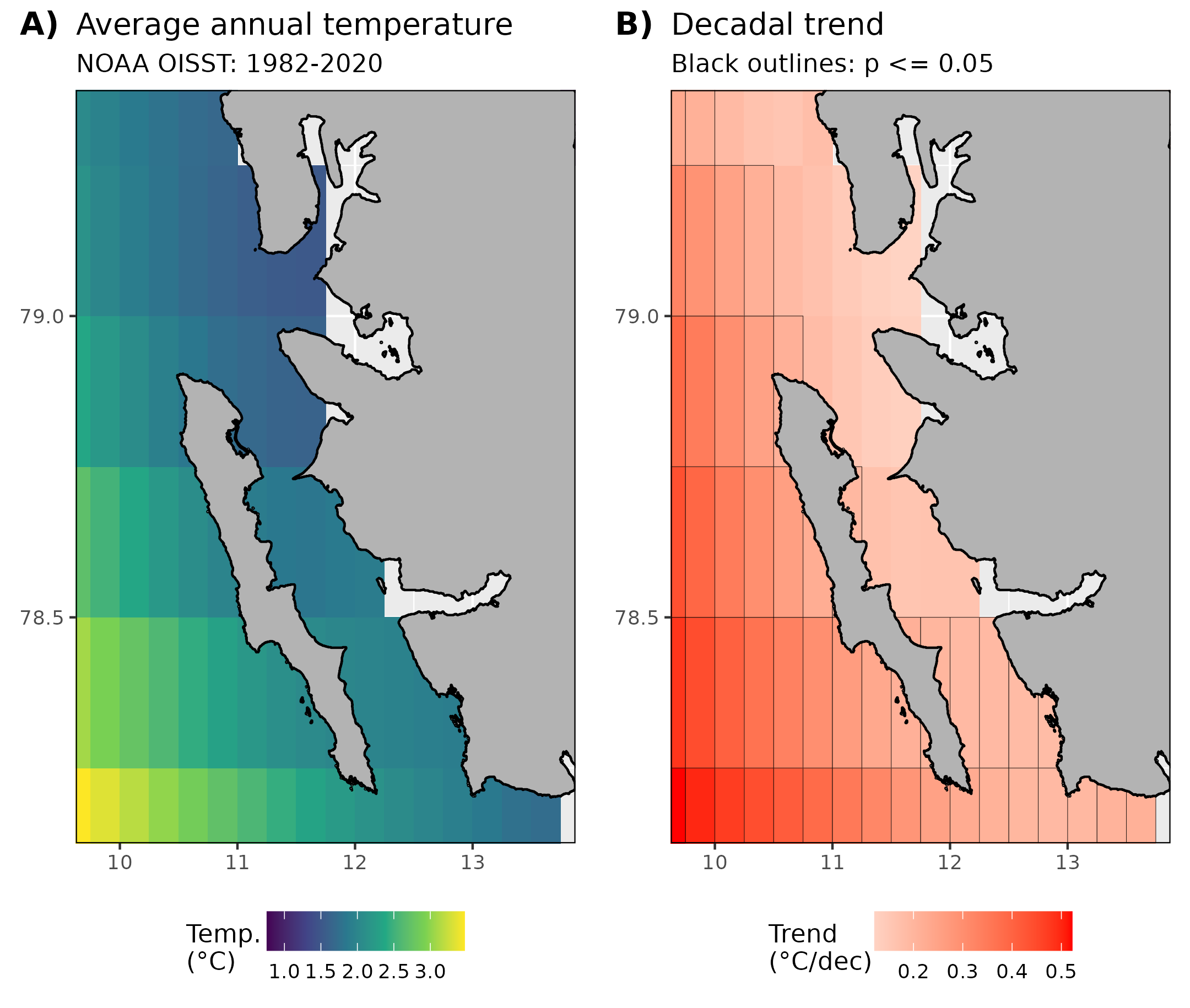
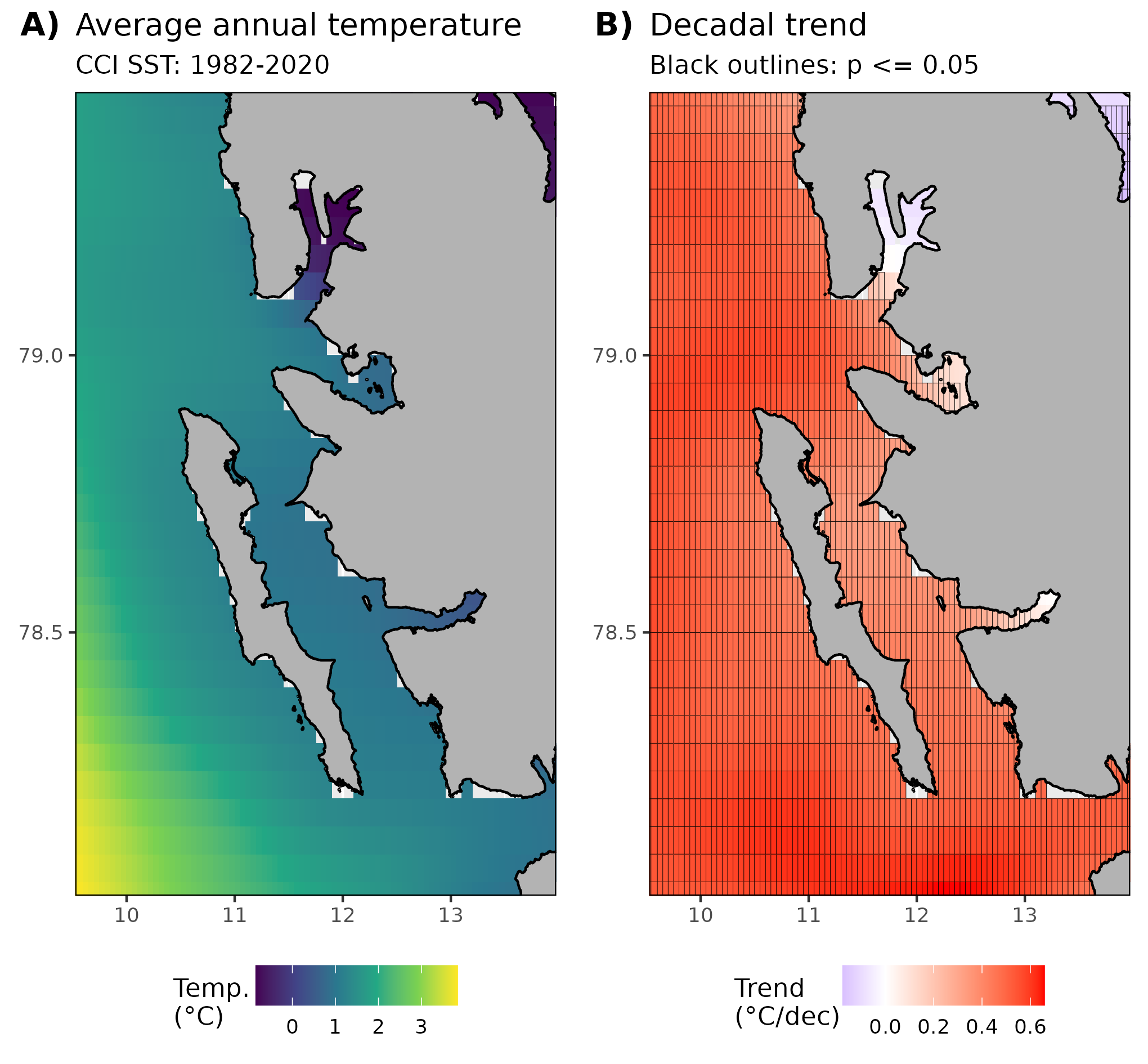
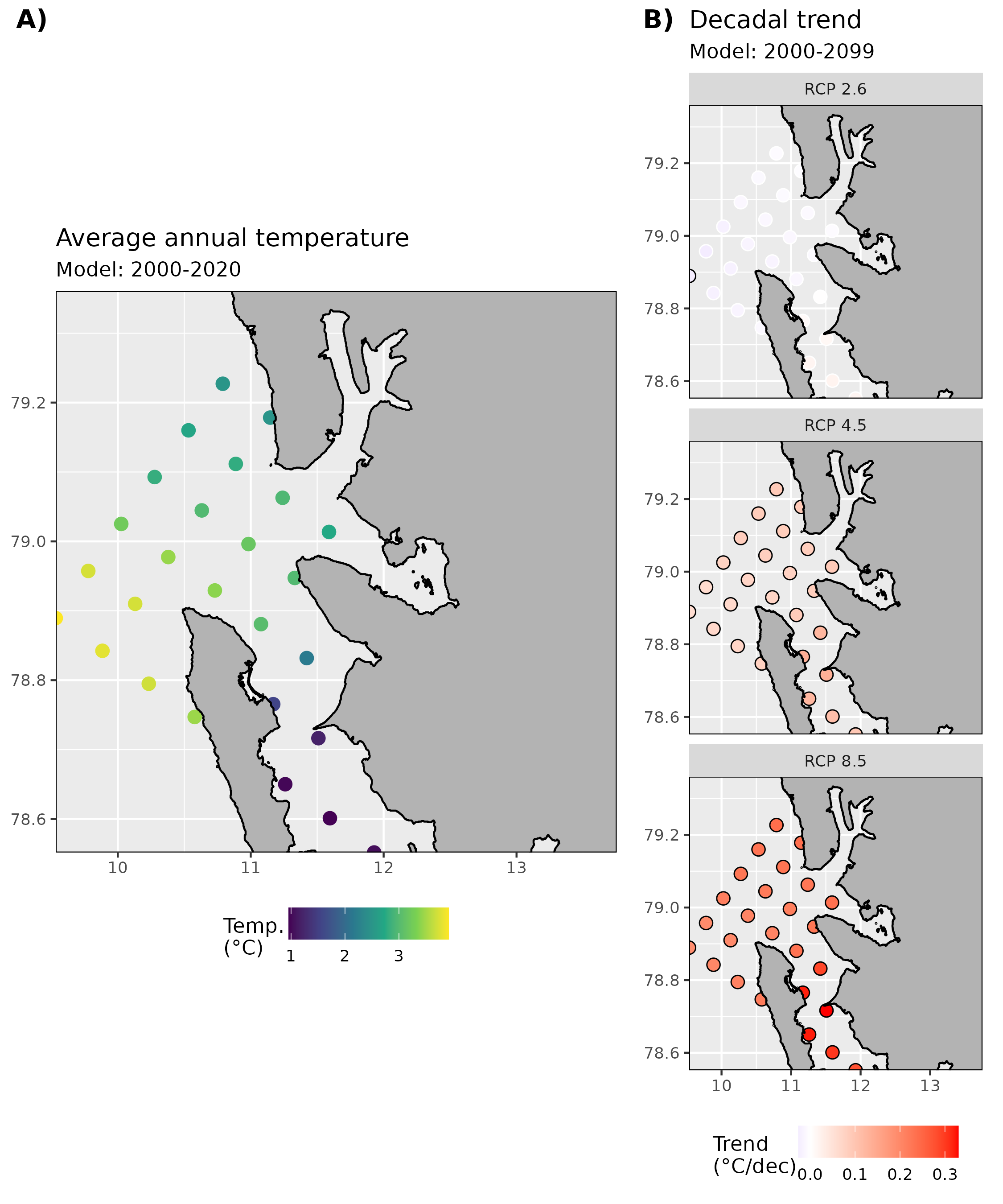
Isfjorden
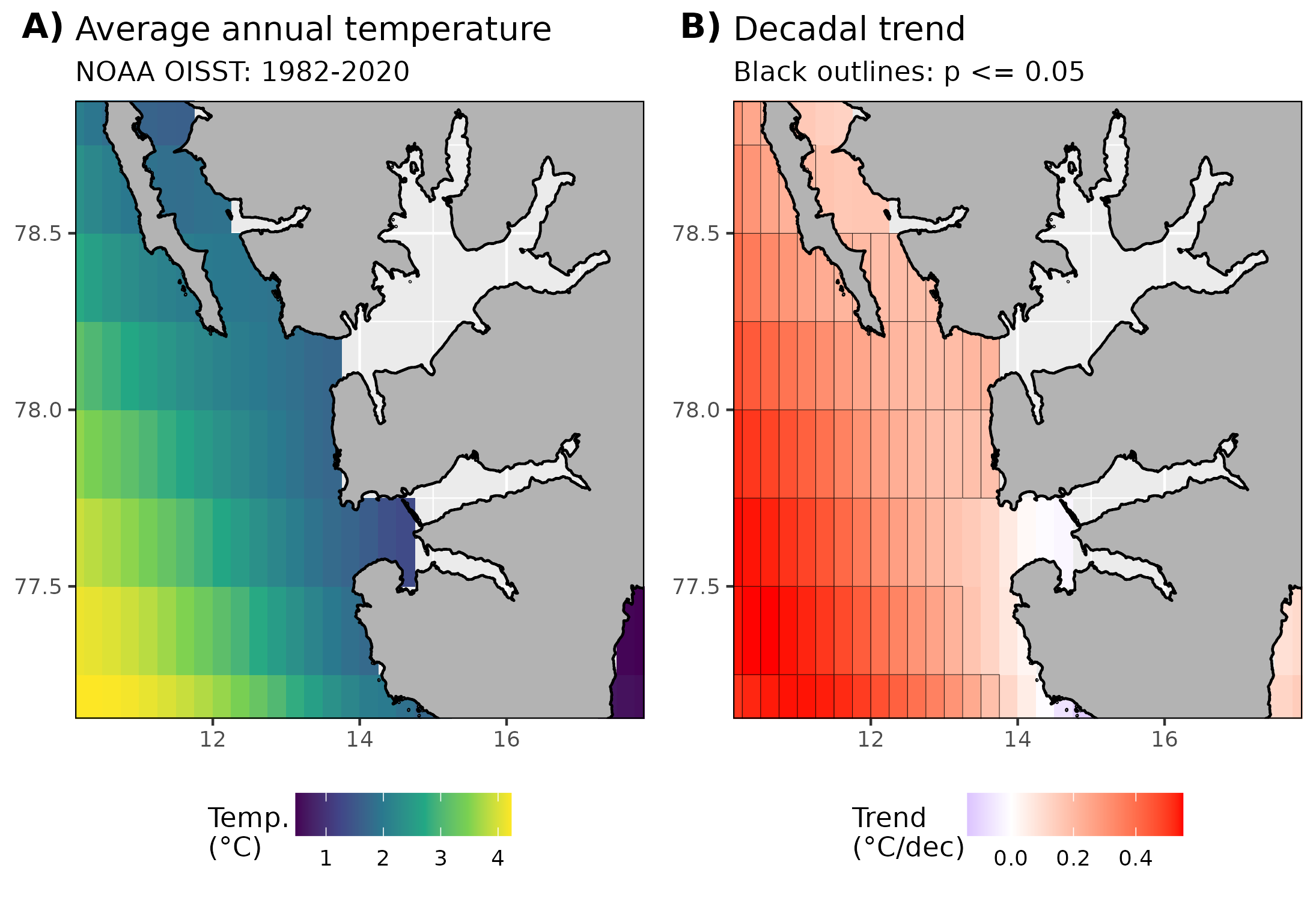
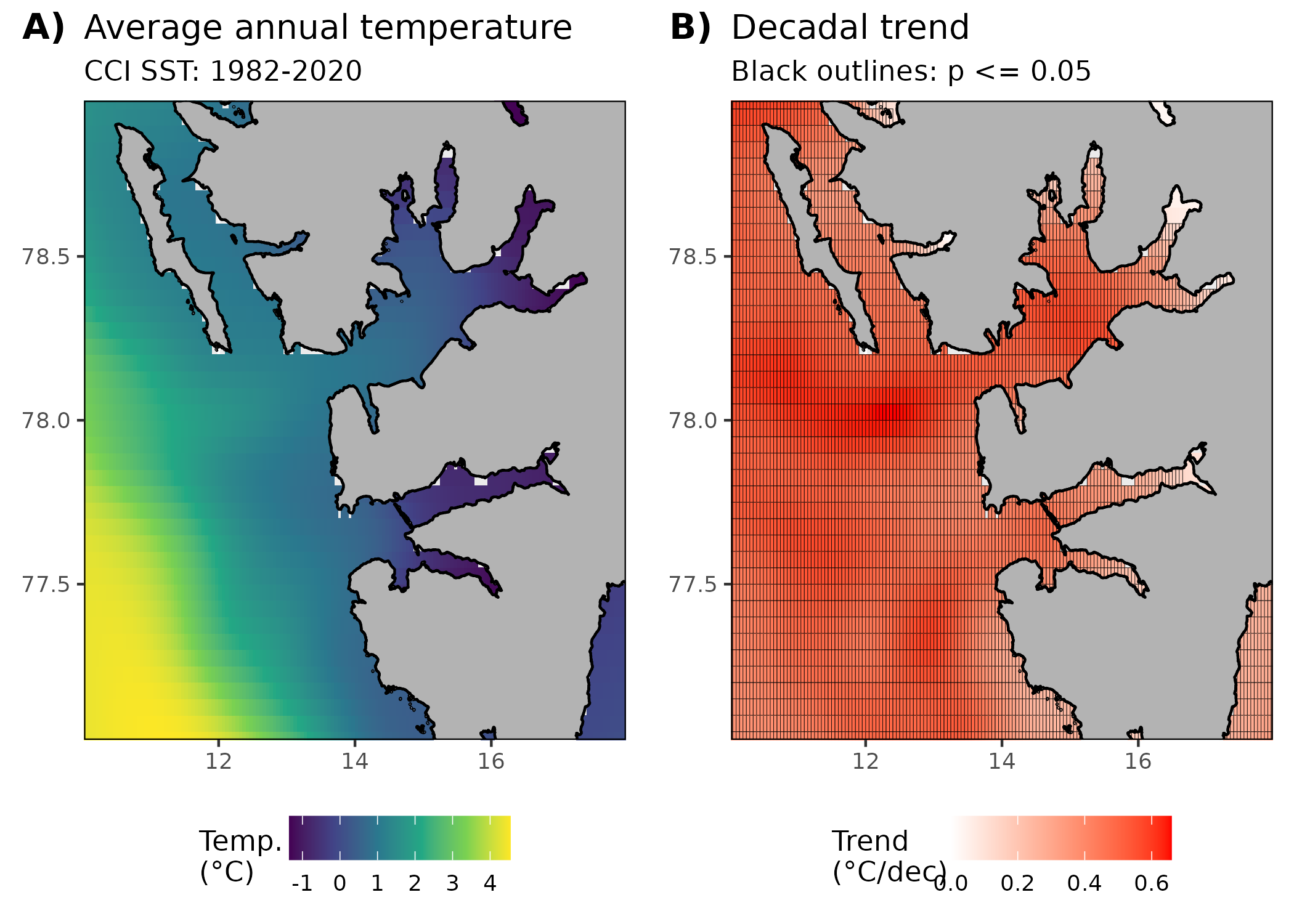
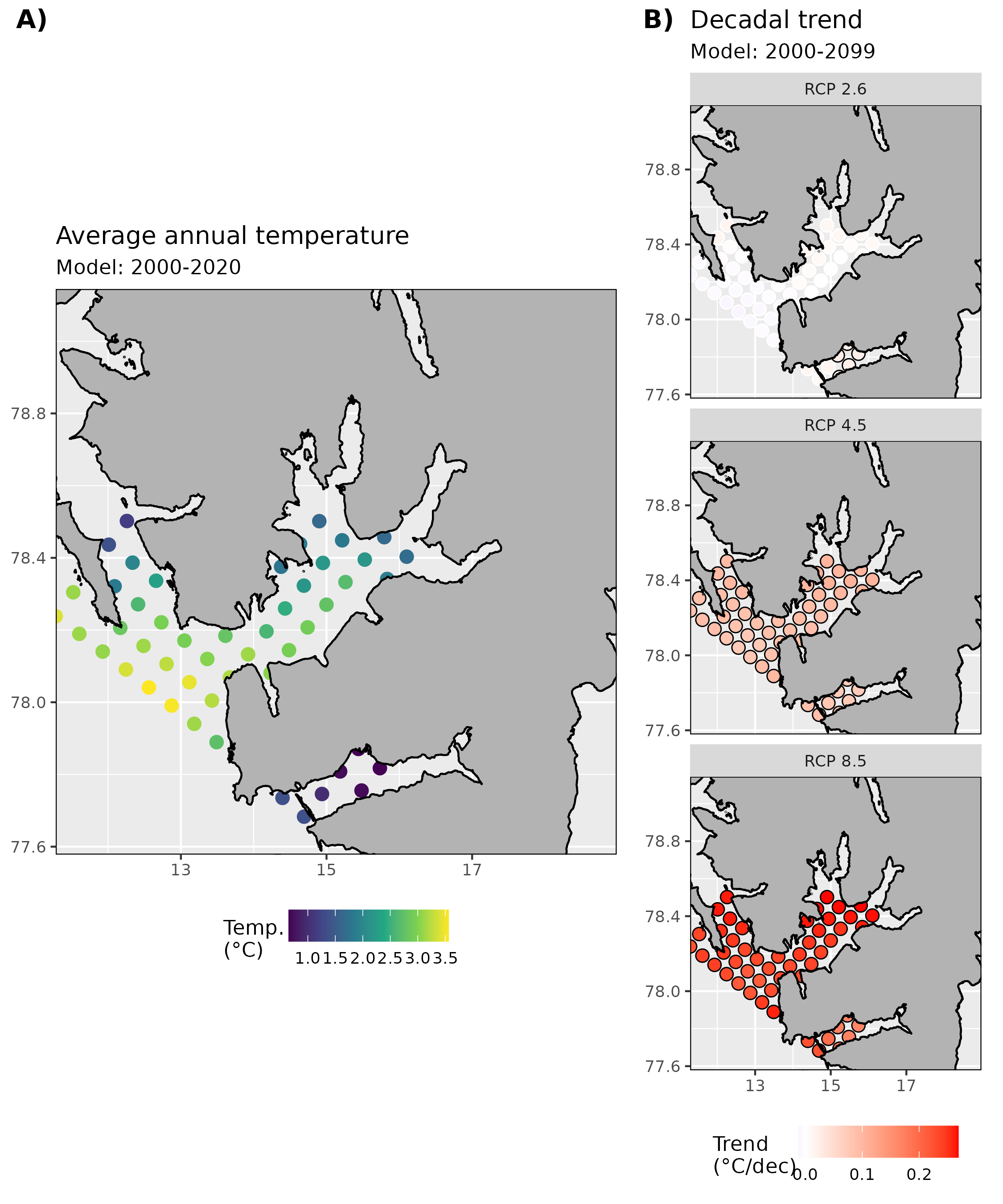
Storfjorden
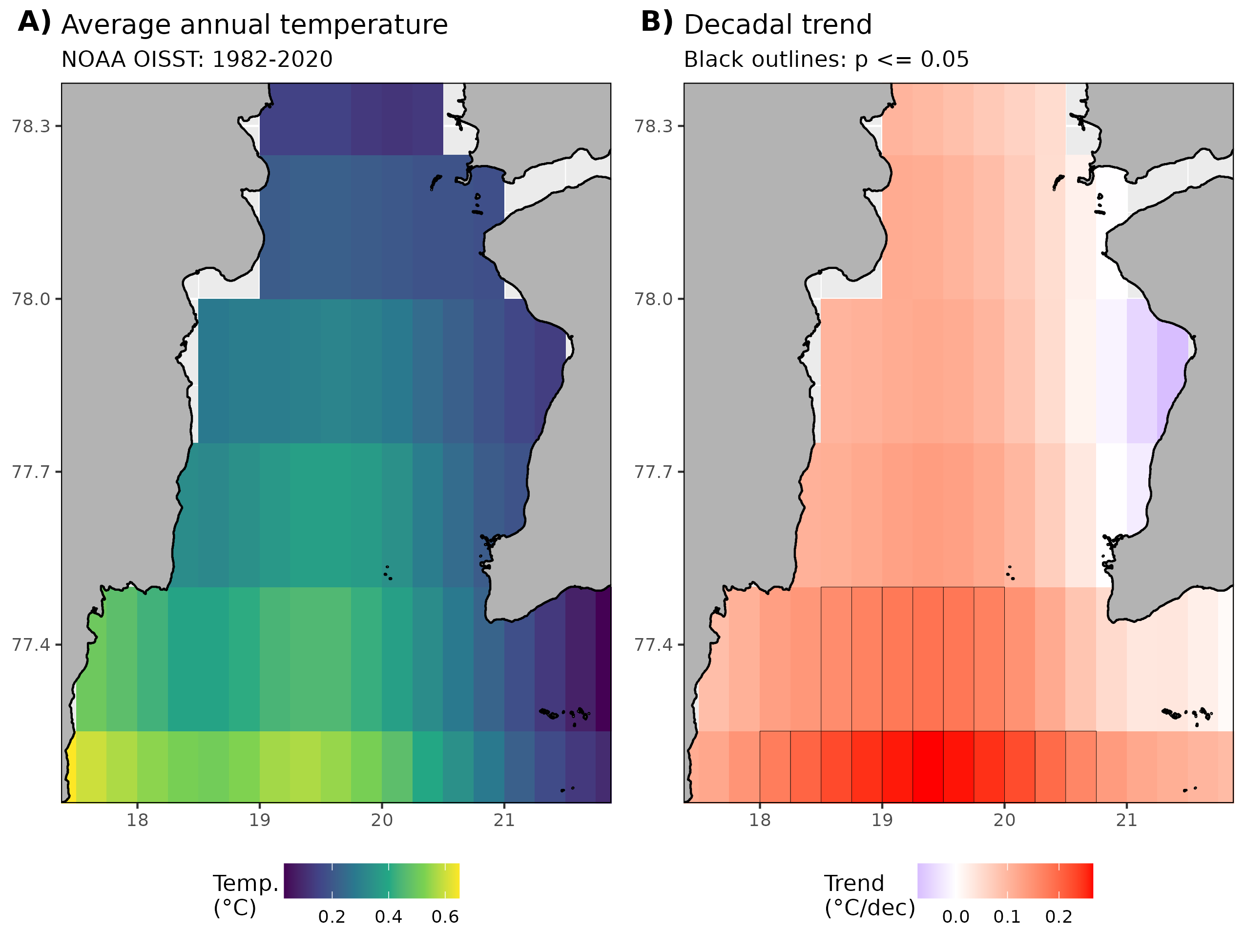

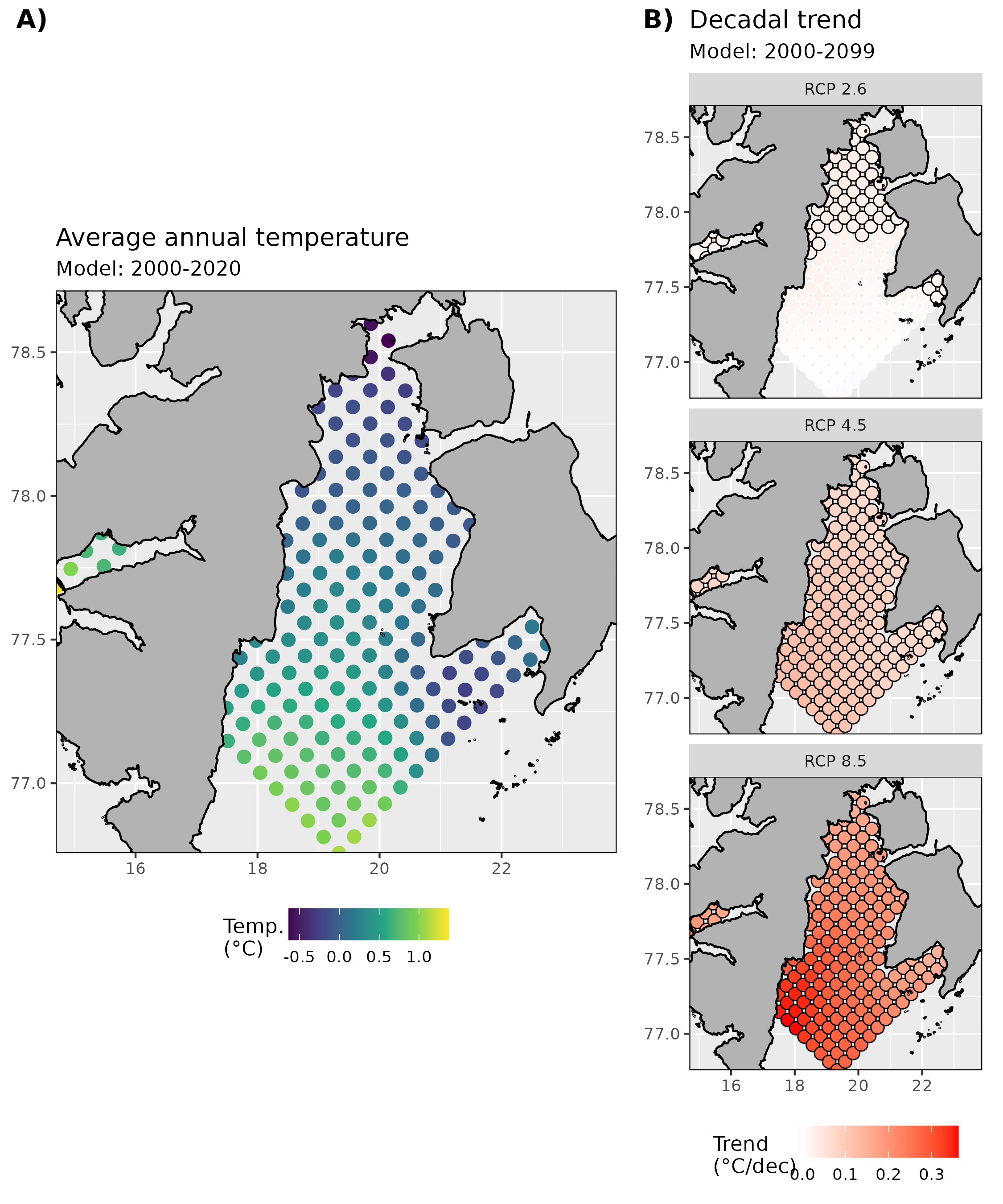
Greenland
Young Sound

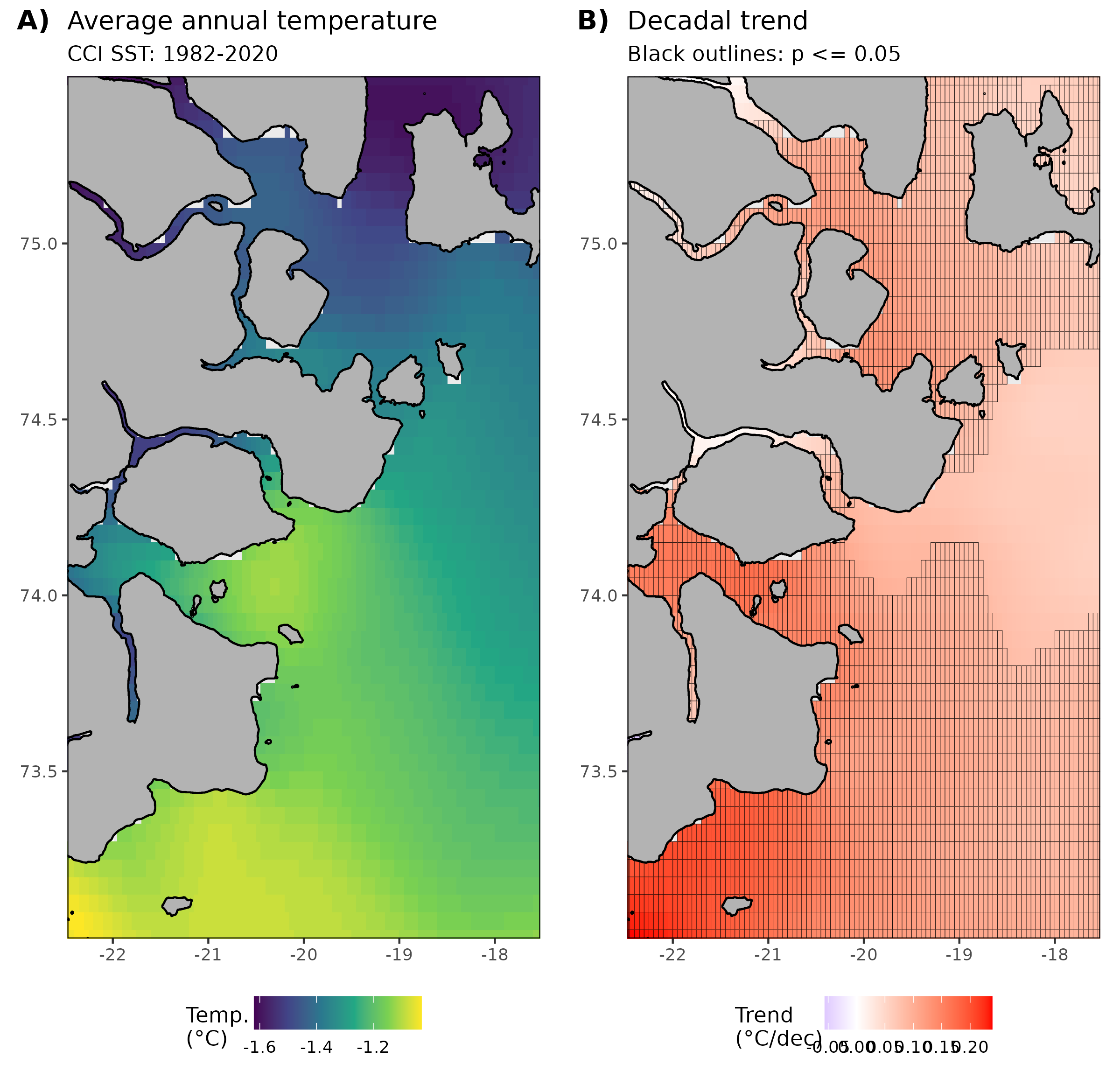

Disko Bay
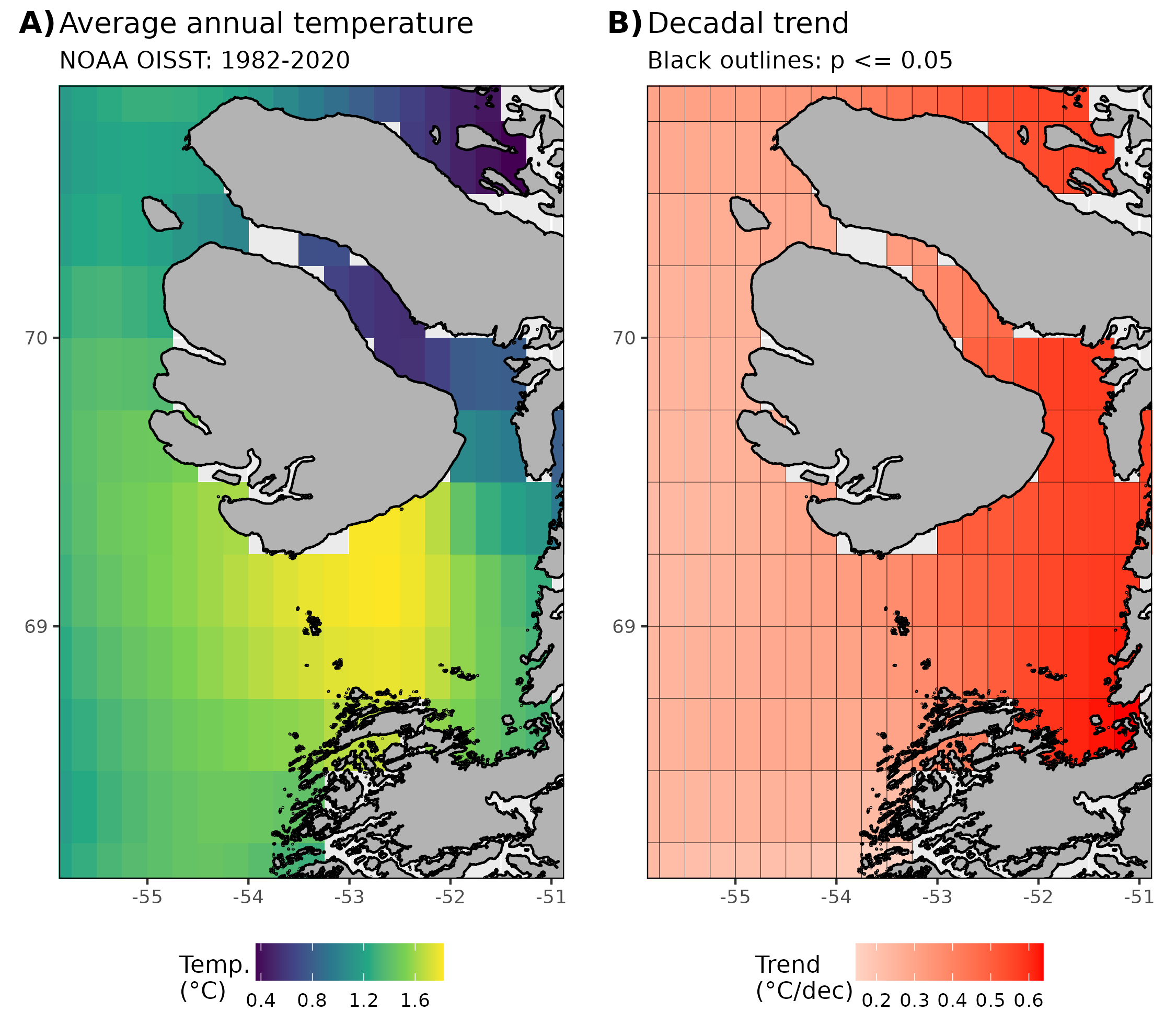
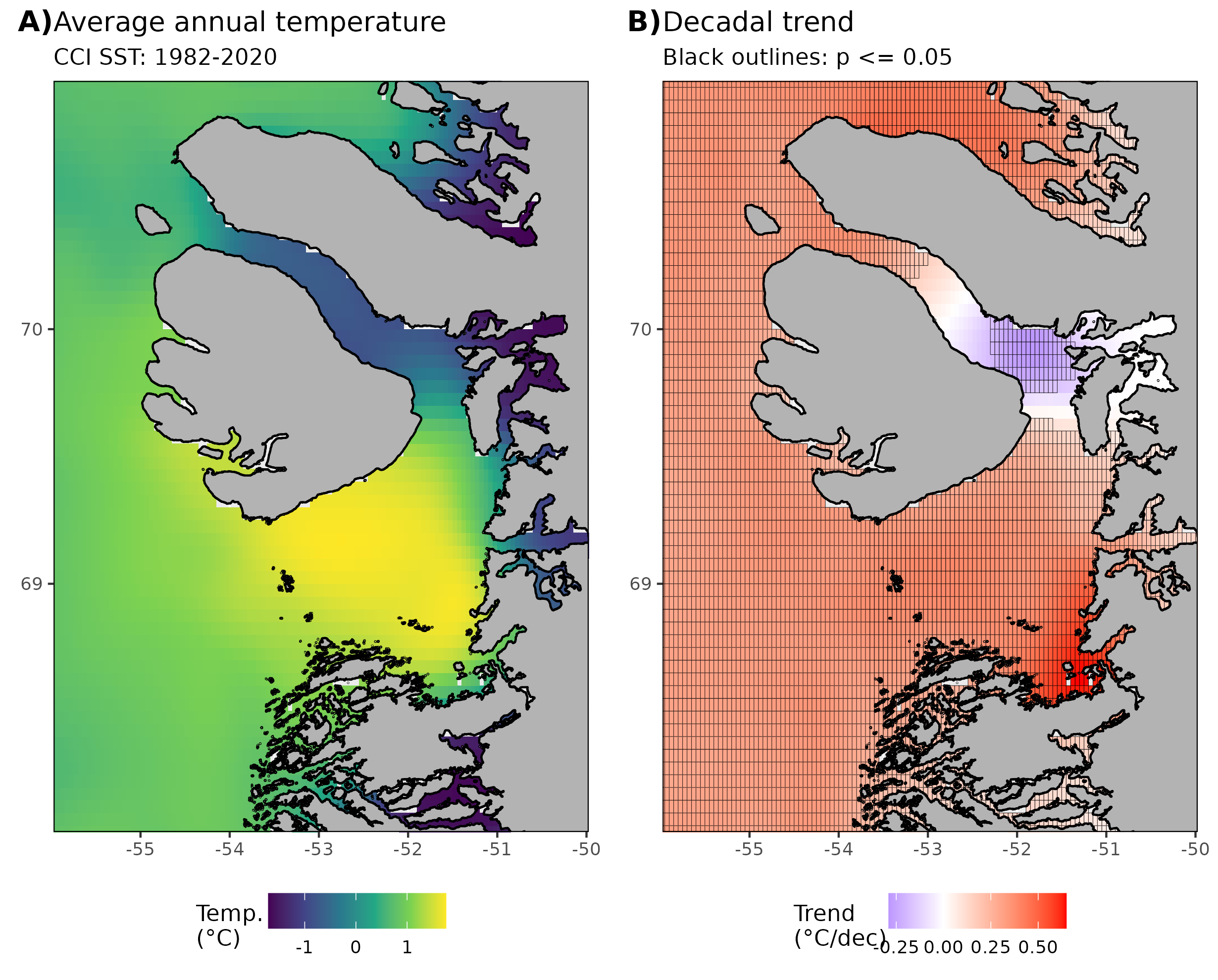
Nuup Kangerlua
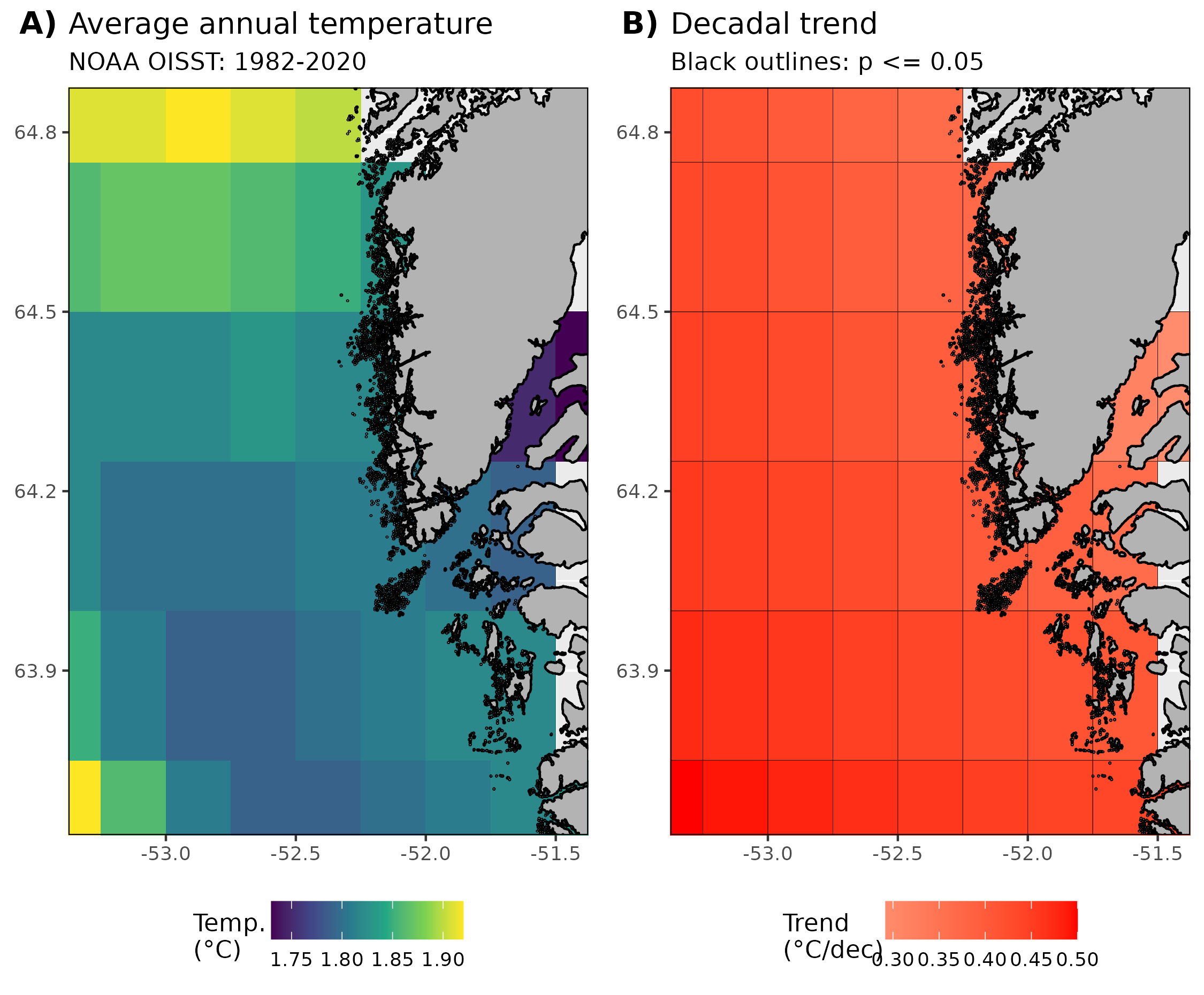
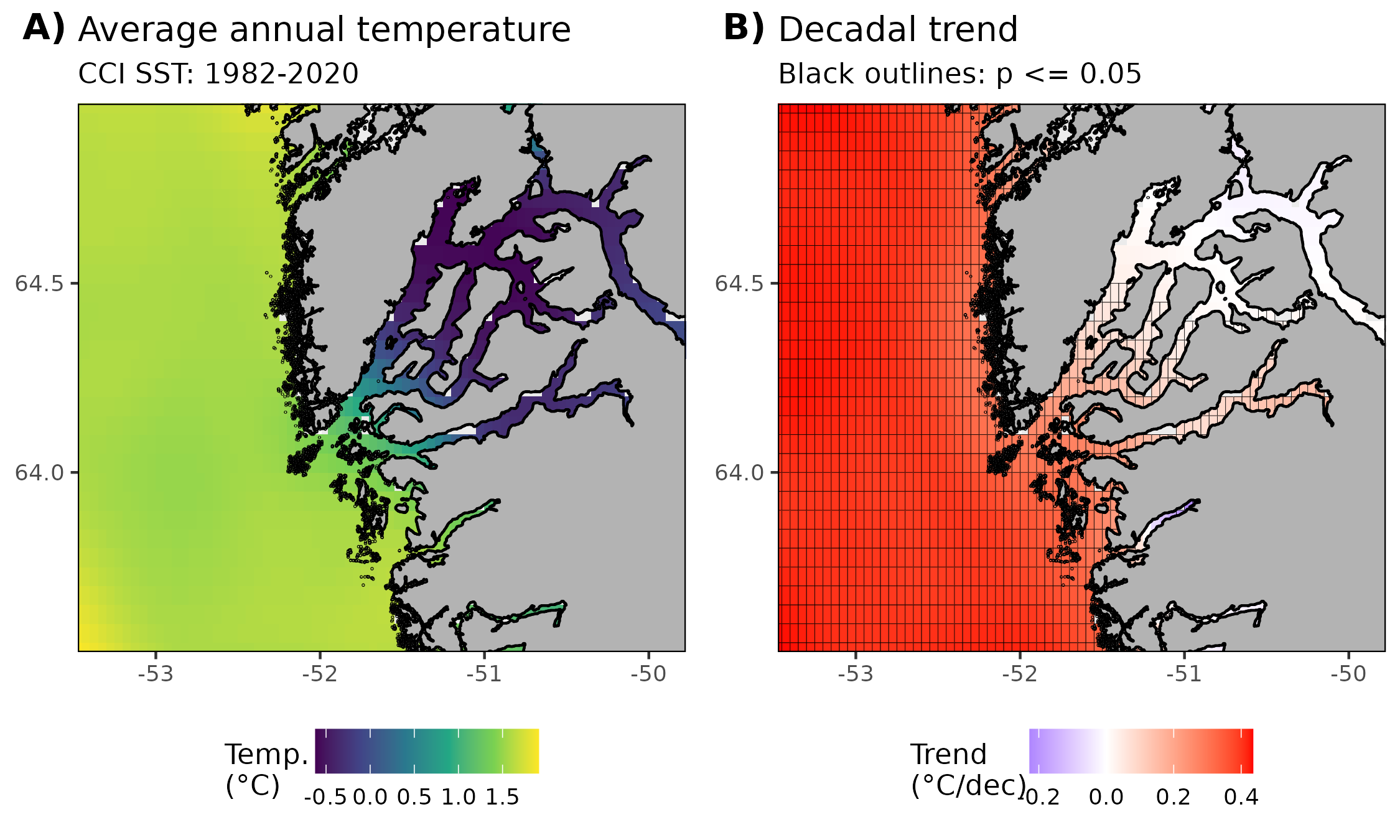
Norway
Porsangerfjorden
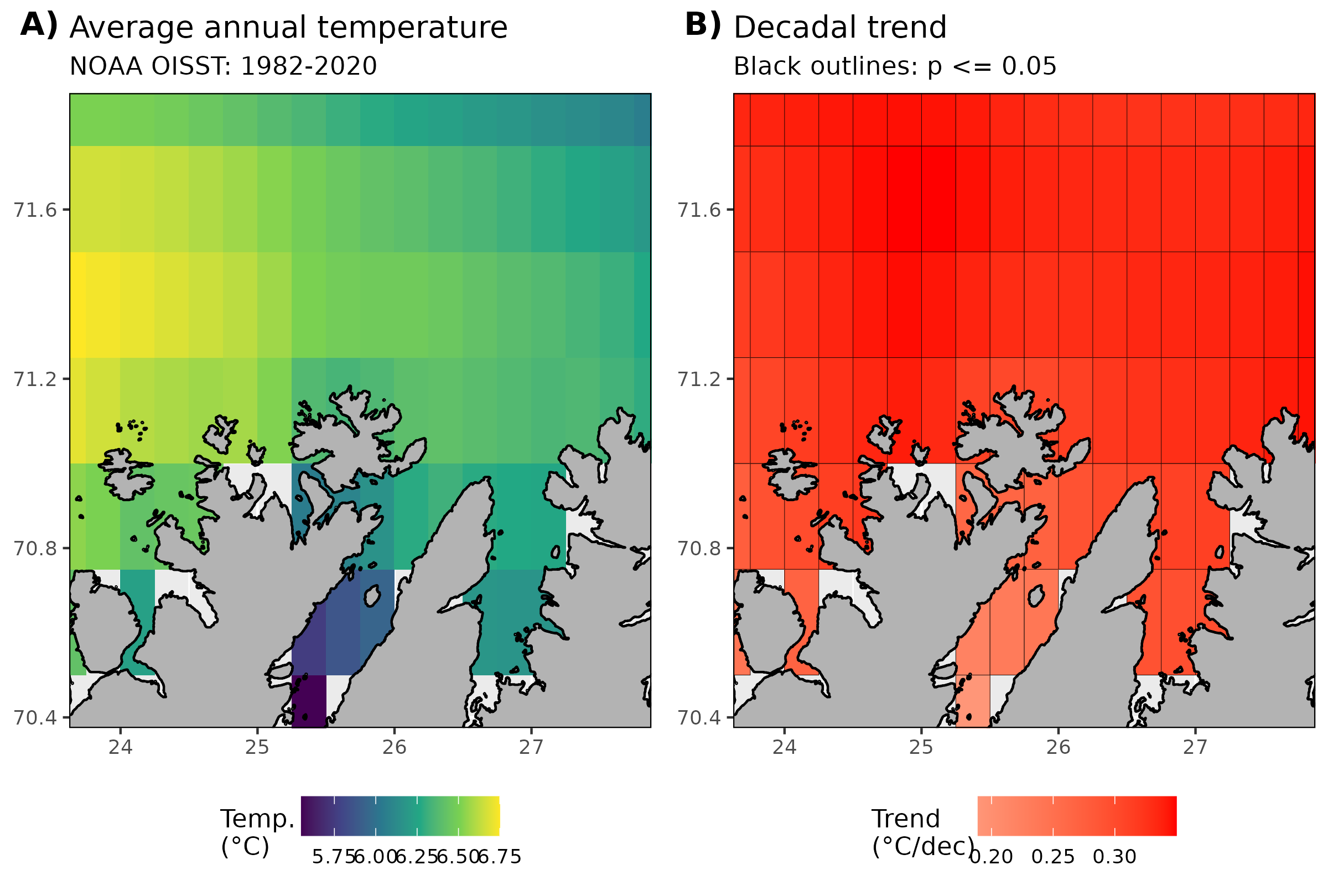
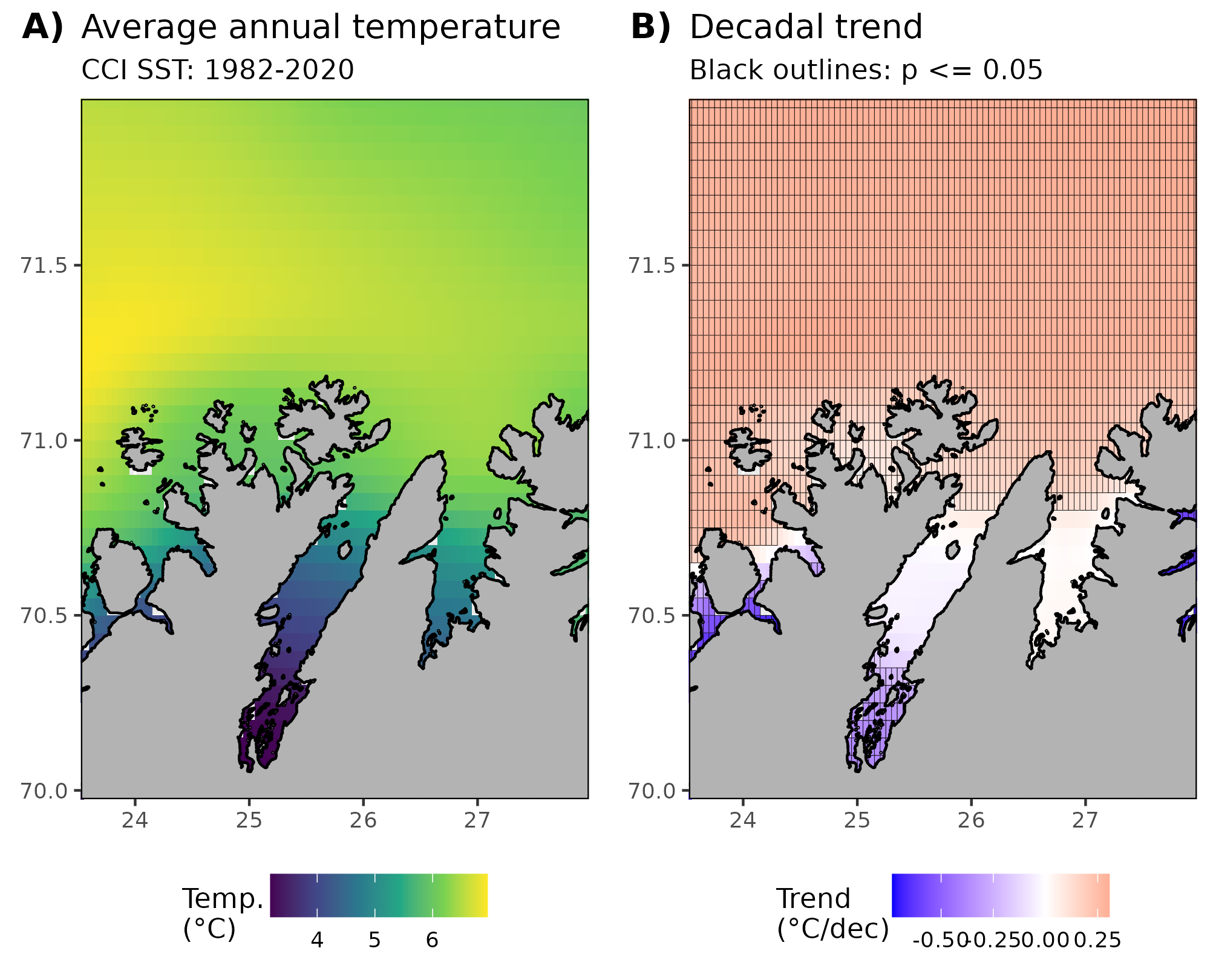
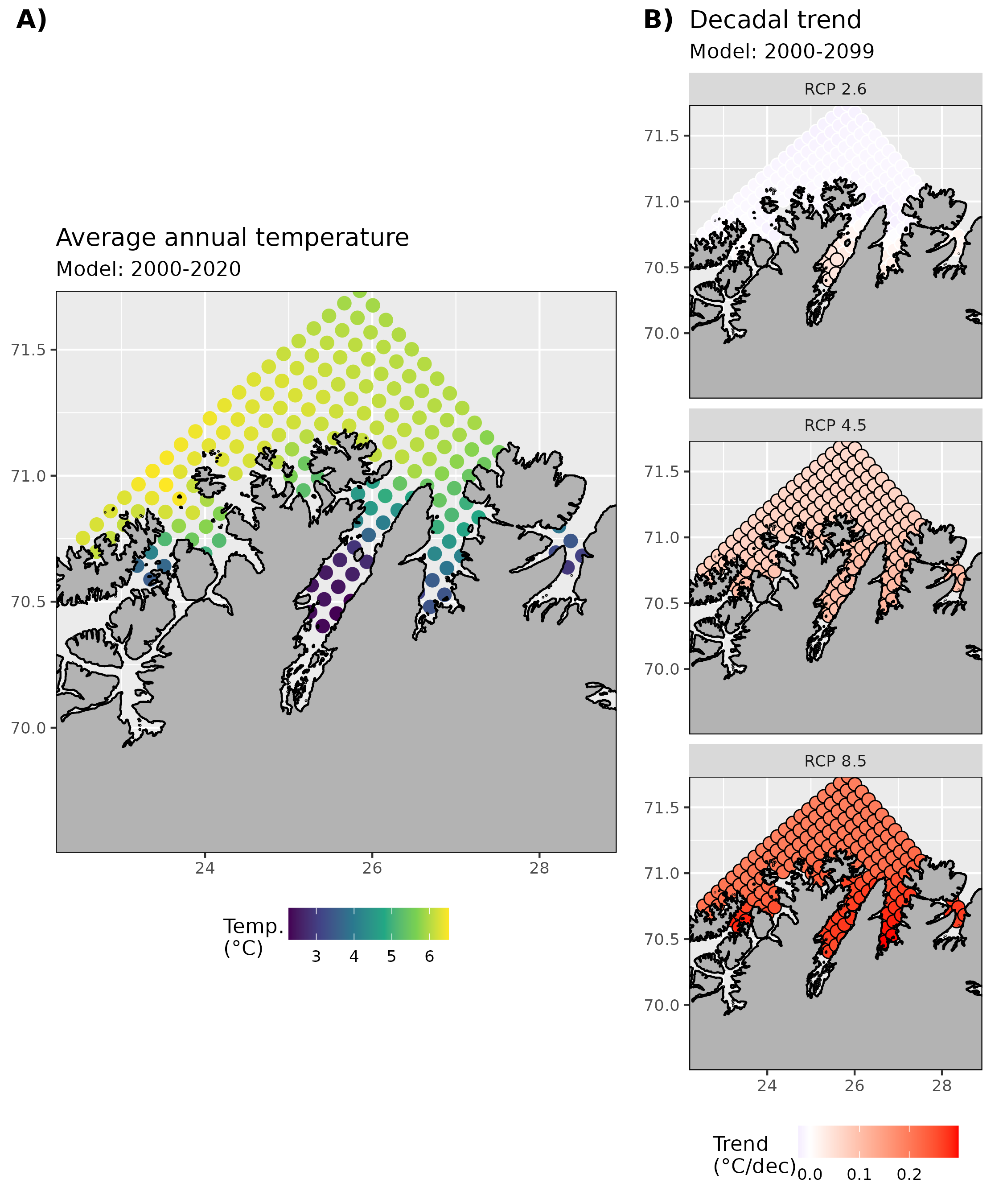
Tromsø
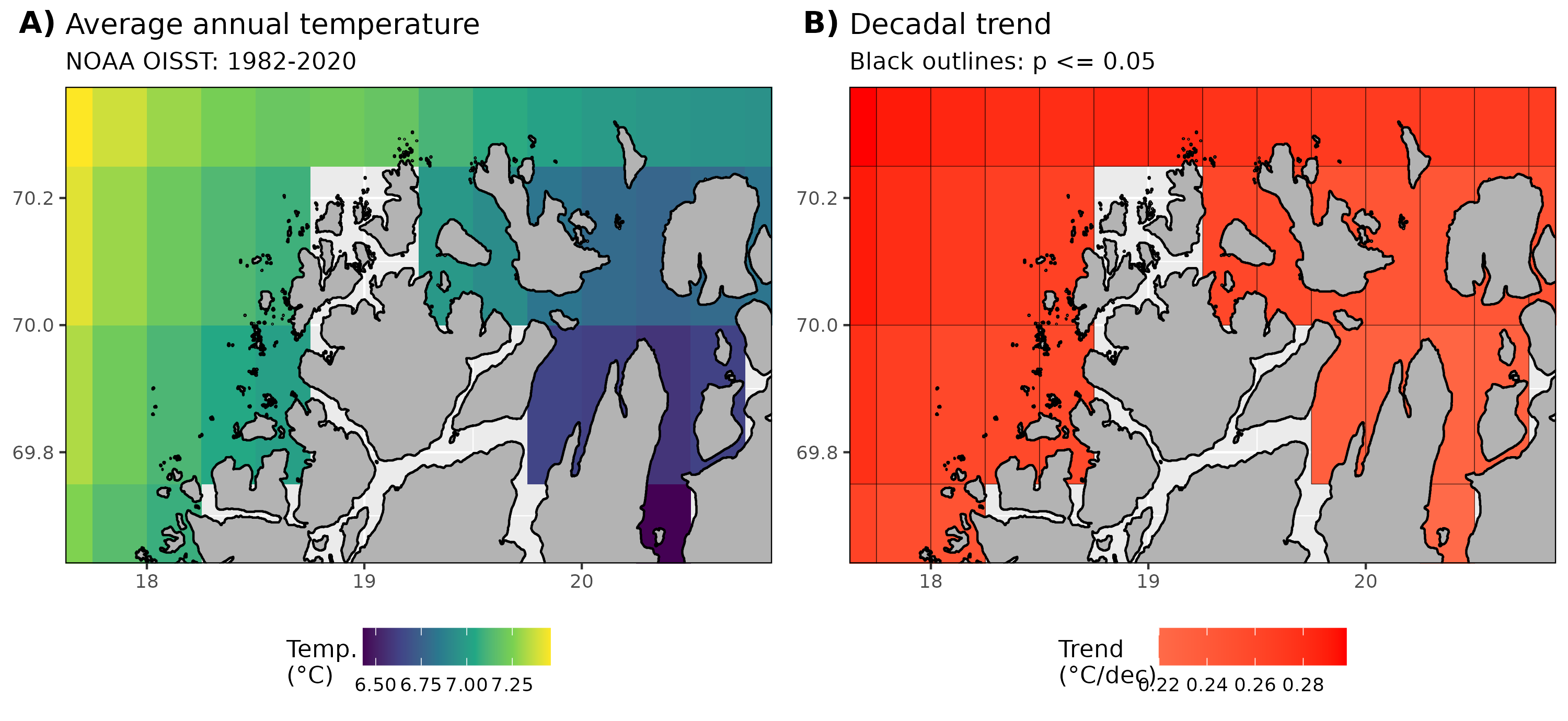
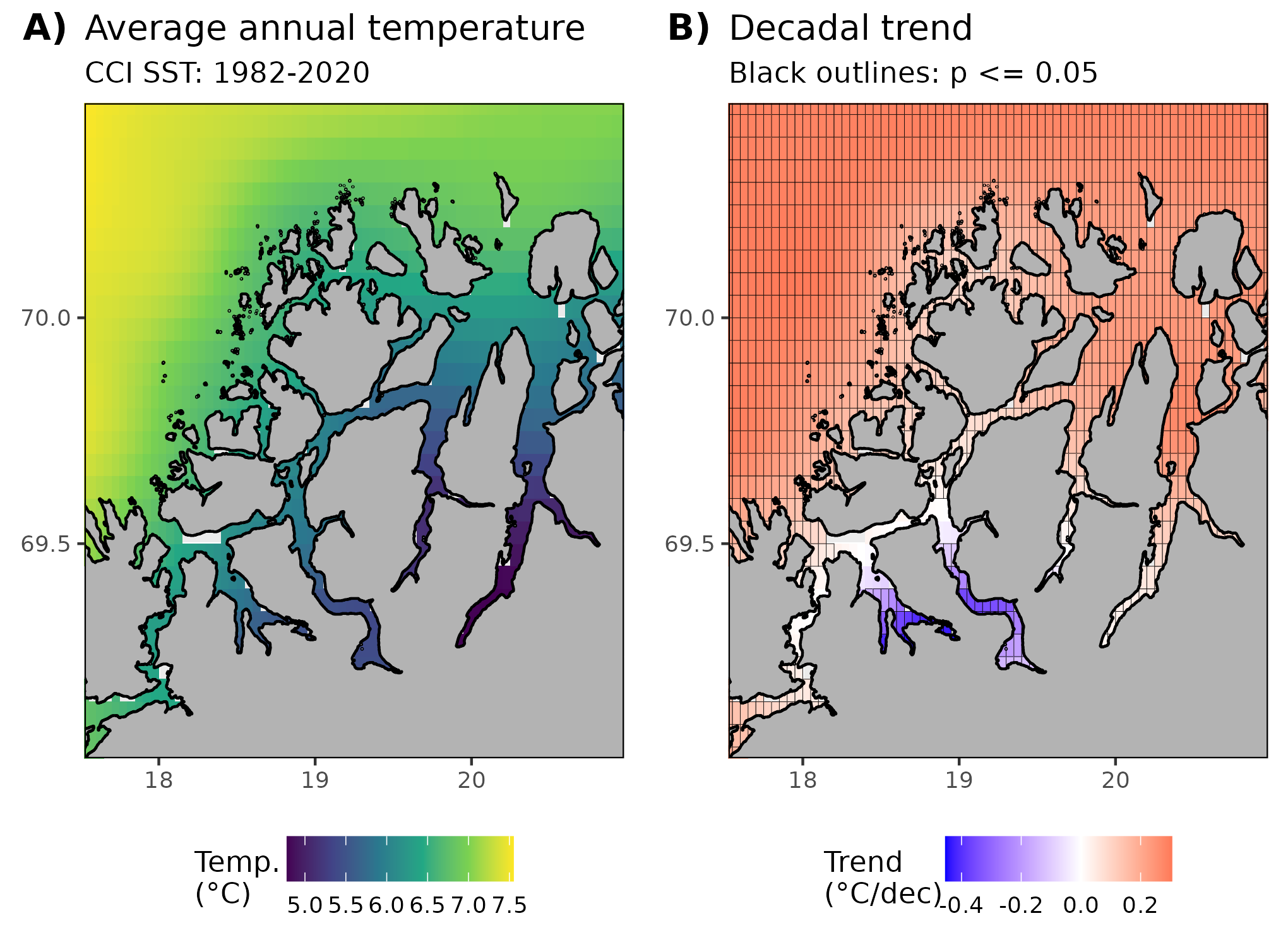
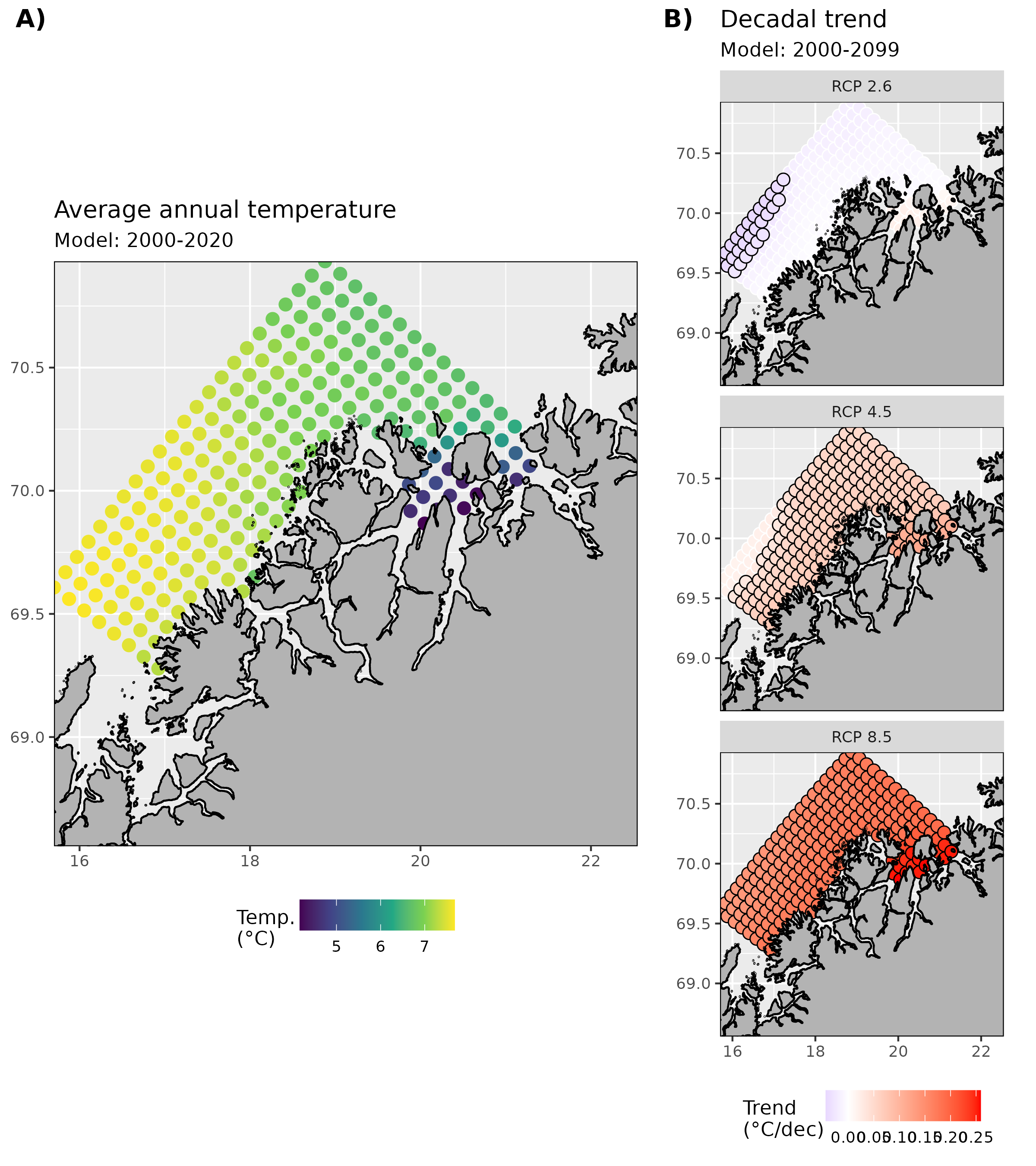
R version 4.3.2 (2023-10-31)
Platform: x86_64-pc-linux-gnu (64-bit)
Running under: Ubuntu 20.04.6 LTS
Matrix products: default
BLAS: /usr/lib/x86_64-linux-gnu/blas/libblas.so.3.9.0
LAPACK: /usr/lib/x86_64-linux-gnu/lapack/liblapack.so.3.9.0
locale:
[1] LC_CTYPE=en_GB.UTF-8 LC_NUMERIC=C
[3] LC_TIME=en_GB.UTF-8 LC_COLLATE=en_GB.UTF-8
[5] LC_MONETARY=en_GB.UTF-8 LC_MESSAGES=en_GB.UTF-8
[7] LC_PAPER=en_GB.UTF-8 LC_NAME=C
[9] LC_ADDRESS=C LC_TELEPHONE=C
[11] LC_MEASUREMENT=en_GB.UTF-8 LC_IDENTIFICATION=C
time zone: Europe/Paris
tzcode source: system (glibc)
attached base packages:
[1] stats graphics grDevices utils datasets methods base
other attached packages:
[1] workflowr_1.7.1
loaded via a namespace (and not attached):
[1] vctrs_0.6.5 httr_1.4.7 cli_3.6.1 knitr_1.45
[5] rlang_1.1.2 xfun_0.41 stringi_1.8.2 processx_3.8.2
[9] promises_1.2.1 jsonlite_1.8.8 glue_1.6.2 rprojroot_2.0.4
[13] git2r_0.33.0 htmltools_0.5.7 httpuv_1.6.13 ps_1.7.5
[17] sass_0.4.8 fansi_1.0.5 rmarkdown_2.25 jquerylib_0.1.4
[21] tibble_3.2.1 evaluate_0.23 fastmap_1.1.1 yaml_2.3.7
[25] lifecycle_1.0.4 whisker_0.4.1 stringr_1.5.1 compiler_4.3.2
[29] fs_1.6.3 pkgconfig_2.0.3 Rcpp_1.0.11 rstudioapi_0.15.0
[33] later_1.3.2 digest_0.6.33 R6_2.5.1 utf8_1.2.4
[37] pillar_1.9.0 callr_3.7.3 magrittr_2.0.3 bslib_0.6.1
[41] tools_4.3.2 cachem_1.0.8 getPass_0.2-2